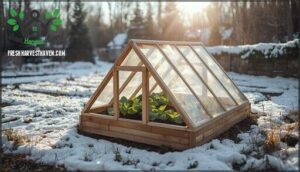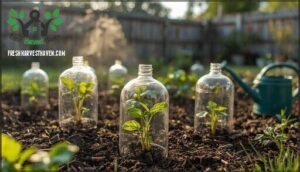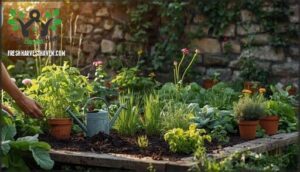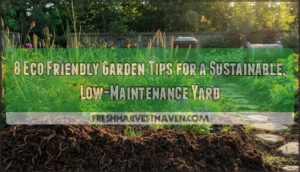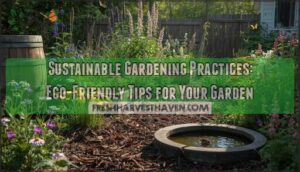This site is supported by our readers. We may earn a commission, at no cost to you, if you purchase through links.

Wind protection alone can boost yields by 30%, and simple passive structures like cold frames add months of productivity without electricity or fancy equipment.
The secret isn’t about fighting your climate; it’s about working with microclimates, strategic crop choices, and soil management to keep fresh food coming when your neighbors’ gardens sit empty.
Table Of Contents
- Key Takeaways
- Key Factors for Extending The Growing Season
- Passive Structures for Season Extension
- Strategic Crop Selection and Planting
- Soil and Environmental Management Tips
- Fresh Food Harvesting and Preservation Strategies
- Frequently Asked Questions (FAQs)
- How can I extend my growing season?
- Should you extend the growing season?
- How do you extend the season?
- What is season extension in horticultural production?
- Why is season extension important?
- What composting methods work best during winter months?
- How do perennial vegetables differ from annual crops?
- When should seeds be started indoors versus outdoors?
- What natural pest control works in cold weather?
- How does companion planting extend growing seasons?
- Conclusion
Key Takeaways
- Wind protection and passive structures like cold frames can extend your harvest window by 4-10 weeks without electricity, while strategic windbreaks alone boost yields by 30% in sheltered zones.
- Succession planting every 2-3 weeks transforms gardens from boom-or-bust harvests into continuous production systems, increasing yield efficiency by 20-30% and delivering fresh food for 9-10 months instead of just a few intense weeks.
- Microclimates created through slope orientation, thermal mass materials, and raised beds can raise temperatures by 3-10°C compared to open ground, letting you grow cold-hardy crops well into fall and winter when neighbors’ gardens sit empty.
- Shifting from single-harvest preservation marathons to continual fresh eating reduces post-harvest waste by 35% while maximizing nutrition, since vitamin C content drops up to 30% in early-picked produce and 51% within 48 hours after harvest.
Key Factors for Extending The Growing Season
Getting your garden to produce longer isn’t about luck—it’s about understanding what makes plants tick. Wind, sunlight, frost, and where you put things all play a major role in keeping your harvest going.
Let’s break down the four factors that’ll help you squeeze extra weeks out of your growing season.
Reducing Wind Exposure
When wind whips through your garden, it steals heat and damages tender plants faster than you can say "microclimate." Creating protective microclimates with smart windbreak design changes everything. A simple 2-meter hedge cuts wind speeds for up to 20 meters into your garden, boosting yields by 30% in sheltered zones.
A two-meter hedge cuts wind speeds for up to 20 meters, boosting sheltered yields by 30% through protective microclimate design
Try planting wind-resistant shrubs as living shelterbelts, or install slatted fences that slow breezes without creating turbulence. Physical barriers like cold frames and sturdy raised beds shield seedlings from wind stress.
Layered planting strategies—tall crops backing shorter ones—diffuse wind energy naturally, turning your garden into a productive haven for plant protection. Implementing strategies to minimize the effects of garden wind stress is essential for plant health.
Maximizing Natural Sunlight
After sheltering your plants from buffeting breezes, turn your attention to sunlight requirements—your garden’s true power source. Most vegetables need 6–8 hours of direct sun daily, so smart garden orientation matters. Position beds facing south to capture maximum rays during shorter days, then add reflective materials like light-colored mulch or aluminum sheeting to bounce 10–30% more light onto lower leaves.
Strategic garden placement near south-facing walls delivers up to 40% greater solar input in early spring through microclimate integration. Understanding how sunlight impacts microclimates is critical for maximizing plant survival. Dark containers and thermal mass materials absorb heat during sunny spells, radiating warmth back at night for natural light trapping.
Seasonal management means adjusting bed angles and pruning obstacles—maximizing natural sunlight transforms those precious winter photons into extended harvests.
Protecting Against Frost and Cold
Sunlight feeds plants, but frost mitigation protects your investment when temperatures plunge. Start with site selection—avoid low spots where cold air pools and raises frost risk by several degrees.
Protective coverings like row covers trap soil warmth radiating upward at night, adding 2°F–10°F of insulation depending on fabric weight. Cold frames offer season-long frost protection through passive solar heating.
For active heating, water your beds before freeze events—moist soil holds more warmth than dry ground, boosting air temperatures near plants. Mulching insulates roots while strategic placement near heat-absorbing walls creates natural microclimate buffers against killing cold.
Garden Placement and Microclimate Use
After you’ve nailed frost protection, think bigger—your garden’s placement orchestrates the whole growing system. Creating protective microclimates starts with understanding microclimates already at work around you.
Slope orientation matters: south-facing spots capture 40% more solar radiation for natural warmth, while low areas become frost pockets 3–5°C colder. Strategic garden placement near brick walls boosts heat retention, extending frost-free days by a week or more.
Wind barriers like hedges cut wind speed by half, improving moisture retention 10–15%. Even soil composition plays a role—organic-rich ground holds 25% more moisture. Water features raise humidity 3–4%, stabilizing seedlings during heat waves.
Enhancing and modifying microclimates transforms ordinary spaces into season-stretching powerhouses.
Passive Structures for Season Extension
When you want to trap warmth and block cold without building a full greenhouse, passive structures step in as your reliable season extenders. These simple setups don’t need electricity or fancy equipment—they just work with sunlight and insulation to keep your plants cozy.
Let’s look at four practical options that can add weeks to your harvest window.
Cold Frames and Their Construction
Think of cold frames as little solar-powered greenhouses that work year-round without costing a dime in utilities. These passive structures for season extension trap sunshine and bump interior temperatures up by 5–10 °C compared to outside air—enough to keep spinach, kale, and lettuce thriving when your neighbors’ gardens are frozen solid. Constructing cold frames doesn’t require fancy carpentry skills or deep pockets, either. Here’s what makes DIY cold frames so effective:
- Frame Materials – Recycled lumber or concrete blocks form sturdy walls that cut costs by half compared to commercial kits
- Temperature Regulation – South-facing placement with sloped glazing captures maximum solar heat during short winter days
- Location Factors – Siting near windbreaks and partially burying the frame preserves 4–8 °C more warmth overnight
- Crop Suitability – Hardy greens tolerate internal temps down to −3 °C, extending your season extension window by 4–10 weeks
Most DIY builds run under $100 and pay for themselves within two seasons.
Hoop Houses and High Tunnels
High tunnels push season extension to the next level—these unheated, plastic-covered greenhouses add 4–6 weeks to your harvest window without burning a single kilowatt. You’ll stretch your growing season naturally while slashing energy use: tunnel construction uses just 2.8 MJ per kilogram of tomatoes versus 53 MJ in heated greenhouses.
That energy efficiency translates directly to your wallet, with yield impacts showing 20–50% higher marketable crops and profit margins triple those of field-grown produce. Economic support through USDA’s EQIP program has helped over 13,000 farmers build these structures since 2009, proving soil sustainability improves year after year under their protective span.
| Performance Metric | High Tunnels | Open Field |
|---|---|---|
| Energy per kg tomato | 2.8 MJ | 7.1 MJ |
| Harvest advance | 2–4 weeks earlier | Standard timing |
| Marketable yield boost | +20–50% | Baseline |
| Profit margin increase | Up to 3× higher | Standard return |
| Season extension gain | +4–6 weeks | No extension |
Row Covers and Floating Covers
For maximum flexibility in extending the growing season, floating row covers deliver impressive results. These breathable spunbonded fabrics—made from polyester or polypropylene—drape right over your crops, warming soil and air by 2–8°F depending on weight. You’ll harvest 1–3 weeks earlier while blocking pests like leafminers and aphids.
Key benefits of floating row covers:
- Boost early yields by 25–60% for warm-season crops
- Protect against frost down to 8°F with heavyweight materials
- Allow light transmission between 30–95% for healthy growth
- Reusable for 2–3 seasons with proper care
Just remember to remove them when flowers appear—your squash and cucumbers need pollinators to set fruit.
DIY Cloches for Individual Plants
Old plastic bottles, glass jars, and clear containers aren’t trash—they’re your ticket to early tomatoes and peppers. These DIY cloches raise soil temperatures by 3–10°C, extending the season by 3–4 weeks while providing frost protection down to 0°C.
Remove caps on sunny days for ventilation strategies that prevent overheating beyond 35°C.
Your homemade cloche material options cost under $5 each yet boost seedling survival by 30–40% through enhanced microclimate control and moisture management during seasonal implementation.
Strategic Crop Selection and Planting
The right crops planted at the right time make all the difference when you’re trying to stretch your harvest window. Smart selection and timing let you squeeze weeks—sometimes even months—more productivity from your garden.
Here’s how to pick and plant strategically for season-long abundance.
Choosing Hardy and Fast-Maturing Varieties
Your crop choices determine whether you harvest in May or wait until July. Cold-hardy vegetables like kale, spinach, and Brussels sprouts shrug off temperatures below 28°F, while semi-hardy beets and carrots handle light frost between 28–32°F. Fast-maturing varieties—think radishes at 25 days or Annie Oakley II okra at 50—race to harvest before weather turns nasty.
Breeding programs have pushed survival limits by up to 1.5 hardiness zones, and purple-pigmented cultivars resist frost damage better than green cousins. Regional adaptations matter too: shifting sowing dates three weeks earlier in high-altitude zones extends your growing window by 15–20%.
Container varieties and strategic crop selection allow for multiple harvests where single plantings once ruled.
Succession Planting Techniques
Staggered planting beats the feast-or-famine cycle that crushes most garden plans. Interval planting puts salad greens in every 10–14 days, beans three times per season, and lettuce four to five rounds for continual harvest. Relay planting layers corn, then beans, then squash for three separate yields from one bed.
Intercropping pairs quick radishes with slower carrots, maximizing space while crop sequencing chains spring radishes into summer squash into autumn broccoli.
These succession planting techniques extend yields 4–10 weeks beyond single plantings, delivering fresh food and real freedom.
Planning for Spring and Fall Crops
Your best move? Count backward from your first frost date—just grab that number, add the crop’s days to maturity plus an extra 10–14 days for slower fall growth, and plant accordingly. Spring kicks off after your last frost (April through June depending on your zone), while fall windows stretch mid-July to late September for cool-season champions.
Here’s what separates the pros from wishful thinkers:
- Hardy variety selection puts "Winter Density" lettuce and "Lacinato" kale in your lineup—these tough cultivars laugh at 28°F nights and keep delivering
- Indoor starts 4–6 weeks before last frost give you a serious jump on spring harvests, turning impatience into early salads
- Disease resistance matters more as seasons shift—choosing varieties bred to handle late-season challenges means your fall broccoli and spinach actually make it to harvest
Zone 7 growers enjoy 200+ frost-free days for double-dipping cool crops, while Zone 4 folks work tighter windows between late April and early October. Either way, succession planting techniques and staggered planting schedules keep food flowing when you match hardy fast-maturing varieties to your microclimate and season extension goals.
Staggered Planting for Continuous Harvest
Once you’ve dialed in your spring and fall selections, planting intervals become your next power move. Instead of dumping all your lettuce seeds into the ground at once, spacing plantings every 10–14 days delivers steady harvests for months—no more drowning in arugula one week and eating store-bought the next.
Succession planting techniques work magic when you pair them with smart crop variety choices:
- Match soil temperature to timing: Beans and cucumbers germinate 30–40% faster above 70°F, letting you tighten summer intervals to 10–12 days
- Blend maturity dates: Combining early-, mid-, and late-season tomato varieties extends harvest windows by 30–45 days without extra effort
- Adapt to seasonal shifts: Fall plantings need longer intervals (add 10–15%) since shorter days slow growth rates
This staggered planting approach boosts yield efficiency by 20–30% while extending the growing season through overlapping harvest windows. You’ll master continual harvest without the overwhelm, turning your garden into a production line that actually matches how you eat.
Soil and Environmental Management Tips
Your soil and environment work harder than you think—they’re not just growing crops, they’re extending your season. Small adjustments to warmth, water, and soil health can add weeks to your harvest window.
Here’s how to make your garden environment work in your favor.
Raised Beds and Mulching for Warmth
When soil temperatures climb 3–6 °C faster than flat ground, you’re looking at weeks of extra growing time. Raised beds act as heat magnets, warming quicker in spring and holding warmth deeper into fall. Build them 6–8 inches high with loose, compost-rich soil for maximum heat retention and drainage.
Layer 2–4 inches of organic mulch around your plants—dark materials like shredded bark absorb sunlight and stabilize soil temperature swings by up to 10 °C. This combo cuts irrigation needs by 25–50% while keeping roots cozy through cold snaps.
| Mulch Type | Soil Warming Effect | Best Season |
|---|---|---|
| Black plastic | +3–6 °C boost | Early spring |
| Straw | Moderate (19–22 °C) | Summer/fall |
| Shredded bark | Steady insulation | Year-round |
| Transparent film | +3.3 °C increase | Seedling stage |
| Wood shavings | Cold resistance | Late season |
Bed insulation using natural materials extends your harvest window by 4–6 weeks in temperate zones. Strategic microclimate control transforms ordinary gardens into season-stretching powerhouses.
Cover Crops for Soil Health
While raised beds warm your soil, cover crops keep it alive between growing seasons. Plant winter rye, crimson clover, or hairy vetch after harvest—they’ll prevent erosion by up to 82%, trap nutrients that would otherwise leach away, and pump organic matter back into tired ground. When you turn them under in spring, you’re banking carbon and feeding billions of soil microbes that make nutrients available to your next crop.
- Erosion reduction: Non-legume covers slash soil losses by 31–100% compared to bare ground
- Nutrient retention: Cereal rye scavenges leftover nitrogen, cutting waterway losses by 48–89%
- Soil biology: Root systems boost earthworm populations and microbial activity by 30–150%
- Economic impact: Long-term use reduces fertilizer needs by 25% through natural nitrogen cycling
Think of cover crops as your garden’s off-season workforce—they’re building soil health while you plan next year’s layout.
Water Management and Irrigation
Mastering irrigation management transforms your garden from survival mode to thriving year-round. Strategic water management extends your harvest by weeks when you match moisture delivery to what your plants actually need—not just what feels convenient.
- Install drip irrigation to achieve 90% efficiency while using 20–50% less water than sprinklers
- Apply 1–1.5 inches weekly for vegetable crops, adjusting for plastic mulch systems that need full amounts regardless of rainfall
- Schedule irrigation based on root depth—corn reaches 20 inches at early stages but needs 36 inches by flowering
- Water in early morning to minimize disease risk from prolonged leaf wetness
- Layer 2–3 inches of organic mulch to boost water retention and regulate soil moisture between irrigations
No-till systems with residue can increase available water capacity by 23%, turning irrigation expansion into smart resource use for season extension.
Enhancing and Modifying Microclimates
Your garden’s microclimates hold untapped potential for serious season extension. Strategic windbreak design cuts wind speed by 30–50%, bumping nearby temperatures up 2°C while slashing water loss. Slope geometry matters too—ridge-furrow layouts capture 10–15% more solar radiation for earlier spring harvests.
Add water trenches to lower daytime heat by 1–3°C and moderate nighttime drops. Canopy density creates temperature swings of 5°C compared to open ground, perfect for tucking cold frames and row covers underneath.
Don’t forget thermal mass—stone walls and water barrels absorb daytime heat, then radiate it back overnight, raising air temps around your plants by 1.5°C when frost threatens.
Fresh Food Harvesting and Preservation Strategies
Extending your growing season means rethinking how you harvest and store your food. Instead of one big harvest followed by months of preservation work, you can keep picking fresh food well into the colder months.
Let’s look at how to shift your approach so you’re eating fresh longer and preserving smarter.
Shifting Away From Single-Harvest Mindset
Most gardeners follow a boom-or-bust calendar that leaves them overwhelmed in August and empty-handed by October. Breaking away from this single-harvest trap unlocks year-round abundance through smart adaptive planning and succession planting techniques. Here’s your roadmap to sustainable yield optimization:
- Design staggered planting schedules at 2–3 week intervals for continual harvest
- Select hardy fastmaturing varieties that thrive across multiple seasons
- Implement season extension structures like cold frames for risk reduction
- Plan multiple small harvests instead of one exhausting marathon session
- Prioritize fresh consumption to improve market stability and resource efficiency
Farmers using these strategies report 30–40% higher yields while cutting post-harvest waste by 35%. You’ll spend less time frantically preserving and more time enjoying what you’ve grown. This approach transforms your garden from a seasonal burden into a reliable food source that delivers fresh produce when you actually want it—not all at once.
Continual Harvest for Fresh Eating
Think of your garden as a living pantry that restocks itself weekly instead of dumping everything on your counter at once. Continual harvest planning synchronizes planting, growth, and harvest cycles, ensuring you have something fresh to eat every week during peak seasons.
By combining cyclic replanting of hardy, fast-maturing varieties with intercropping strategies—like tucking quick radishes between slower perennials—you’ll create overlapping harvest windows that keep your kitchen stocked. Self-sowing annuals, such as parsley, regenerate on their own, while staggered planting of lettuce and spinach every two weeks guarantees crisp greens for months. Season extension structures protect late-season crops, making fresh eating the norm instead of the exception.
| Planting Strategy | Harvest Frequency | Fresh Advantage |
|---|---|---|
| Succession planting every 2–3 weeks | Up to 14 consecutive weeks | Steady supply, no waste |
| Perennial vegetables | 5+ years after planting | Minimal replanting effort |
| Fast-maturing crops (25–45 days) | Multiple cycles per season | Peak nutrition retained |
| Self-sowing annuals | Regenerates annually | Hands-off harvest windows |
Reducing Reliance on Preservation
When you grow fresh produce across nine to ten months instead of just a few intense weeks, you’re not scrambling to preserve everything before it rots. Crop diversification with staggered planting for continuous harvest means you’ll eat most of what you grow at peak nutrition, cutting preservation demand by 30–40%. Seasonal planning through passive management—using cold frames, hoop houses, and root cellars—extends harvest time naturally without energy-guzzling appliances. Here’s how reducing reliance on preservation reshapes your garden rhythm:
- Plant succession crops every 2–3 weeks for overlapping harvest windows
- Use minimal processing techniques like cool storage to maintain freshness
- Install passive structures that extend growing seasons by 6–10 weeks
- Choose hardy varieties like kale and leeks for direct winter eating
- Connect with community distribution networks for local fresh-food access year-round
This approach transforms season extension into a fresh eating lifestyle.
Planning Preservation for Peak Nutrition
When preservation becomes necessary, timing separates so-so nutrition from superior nutritional quality. Harvest tomatoes and carrots at peak ripeness—you’ll retain up to 30% more vitamin C compared to early picking.
Blanch vegetables before freezing to lock in 90% of vitamins, and freeze immediately after harvest to prevent the 51% vitamin loss that happens within 48 hours.
Smart meal planning aligns preservation schedules with harvest peaks, maximizing nutrient retention while minimizing your workload and waste.
Frequently Asked Questions (FAQs)
How can I extend my growing season?
You can’t fight Mother Nature, but you can outsmart her. Extend your season length by reducing wind exposure with strategic windbreaks, maximizing natural sunlight, and using season extension methods like cold frames, row covers, and mulching for frost protection.
Together, these natural season extension techniques boost maximizing garden yield for your season extension crops.
Should you extend the growing season?
Absolutely—season extension boosts food security, economic viability, and personal health while improving resource efficiency.
You’ll reduce environmental impact through smarter frost protection using cold frames and row covers, stretching your growing season for continuous fresh harvests.
How do you extend the season?
You’ll extend your season through strategic planning, microclimate creation, and smart crop selection. Cold frames and row covers trap warmth, while raised beds with mulching boost soil warming.
Season extension thrives when you combine these protective structures with hardy varieties and staggered planting schedules for extending harvests year-round.
What is season extension in horticultural production?
Season extension in horticultural production uses protective structures and techniques—like cold frames, row covers, and mulching—to prolong the growing season beyond its natural limits.
This approach yields multiple benefits, including boosting yield improvement, crop quality, market availability, and food security, while also reducing economic risks.
Why is season extension important?
You might think it’s all about more tomatoes, but the real win runs deeper. Economic benefits matter—extra harvests can boost farm income considerably. Food security improves when homegrown food flows year-round, reducing reliance on distant supply chains.
Environmental advantages pile up too: less transportation, fewer emissions, healthier soil. Local impact strengthens communities, while health benefits from fresh eating keep your diet diverse and nutrient-rich.
Strategic crop selection and planting turns your garden into a powerhouse.
What composting methods work best during winter months?
Hot composting with insulated piles generates enough internal heat—around 150°F to 175°F—to keep decomposition active through freezing temps.
Layer browns like raked leaves and wheat straw with greens, maintaining a 25:1 carbon-to-nitrogen ratio for steady microbial activity and rich compost by spring.
How do perennial vegetables differ from annual crops?
Perennial vegetables live for years—some like asparagus produce for 10-15 years—while annuals complete their lifecycle in one season.
You’ll invest more effort upfront establishing perennials, but they need less replanting and tilling afterward.
Their deep roots improve soil health and reduce erosion, plus they often show stronger pest resistance than annuals.
When should seeds be started indoors versus outdoors?
Your indoor timing depends on frost dates and soil temperature. Start heat lovers like tomatoes and peppers indoors 6-8 weeks before your last frost—they’re fussy about warmth.
Direct sow cool-season crops like lettuce outdoors once the soil’s workable in early spring.
What natural pest control works in cold weather?
Row covers and physical barriers work beautifully in cold weather, blocking pests while trapping warmth. Heavyweight fabrics offer frost protection and exclude pests at 90-95% effectiveness.
Beneficial organisms like ladybugs stay active above 50°F, and neem oil sprays remain effective near freezing for fall garden protection.
How does companion planting extend growing seasons?
Companion planting won’t magically shield crops from frost, but it creates subtle microclimatic shifts that keep plants healthier longer. Tall companions act as windbreaks, reducing temperature swings by a few degrees. Dense plantings trap warmth near the soil, while nitrogen-fixing legumes boost soil health, supporting extended harvests and stronger late-season growth.
Conclusion
Think of your garden as a relay race rather than a sprint—each season passes the baton to the next. By extending the growing season naturally through wind protection, passive structures, and smart crop choices, you’re not just adding weeks to your harvest calendar.
You’re building a system that keeps producing when others have quit. The difference between a gardener who eats fresh in October and one who doesn’t isn’t luck or climate—it’s understanding how to work with what nature already provides, turning limitations into opportunities for year-round abundance.

